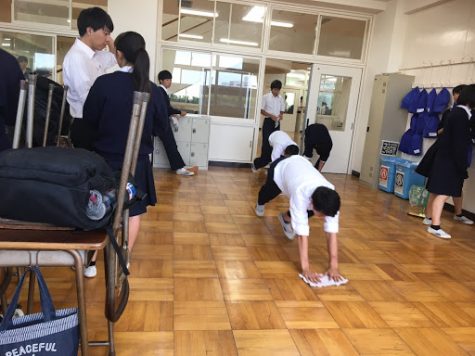School Rules: A Comparison of Japanese and American Student Life

School Rules: A Comparison of Japanese and American Student Life
My name is Karin Imami, and I’m a Japanese exchange student.
I’m in the second grade of high school in Japan, and I graduate high school next year. Since I came here, I have noticed a lot of differences between Japan and the US.
Sometimes, it is hard to get used to it.
I’m going to show how different the two schools are.
Schools in Japan have many rigid rules. At the beginning of the year, the school provides each student with a handbook of rules. If students break those rules, they receive a punishment called “student guidance,” which is recorded on their report card. If a student receives this punishment, it can be hard to get into college.
Here are just a few examples of the school rules in Japan:
We wear a school uniform.
Maybe most of you have seen a picture of a school uniform. Well, here is mine. Most of the public schools’ uniforms are navy blue, and students often think those school uniforms are unstylish. In my opinion, the uniform for private high school, which replaces plain shirts with checked ones, is a little cuter than this one.
No make up, hair dye, or jewelry allowed.
This rule is very strict. My school has a hair and uniform inspection every month.
Teachers make sure that our skirts were long enough, that our ears weren’t pierced, and so on.
The school’s policy on hair was especially ridiculous, in my opinion.
Students who have naturally curly or brightly colored hair are expected to complete an application form.
Some schools require students to dye their hair to black because it’s too bright – despite the fact that their rulebook specifies that students are not allowed to dye their hair at all.
Students must clean the school.
After all the classes are over, the cleaning time starts.

All students share the responsibility of cleaning the school. We clean homeroom, the gym, the hallway, the bathroom, and so on.
At the end of the term, there is “general cleaning,” a period when students have to clean more carefully.
It’s been one month since I came here, and there are already so many differences that I can see.
In Japan, I had a clothing regulation and felt forced to do that and sometimes it was stressful for me. Whereas, in Rhinebeck, I can wear whatever I want.
I already feel great about it. When friends tell me “I love your sweater,” I feel so happy. I cannot experience that in Japan.
I’m already enjoying the differences between these two schools.





